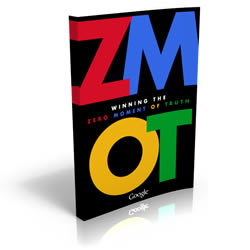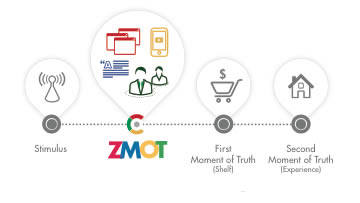Marketing
Google’s "Zero Moment Of Truth": Why They’re Right And Why They’re Wrong
 A few weeks ago Google launched their first business book, ZMOT: Zero Moment Of Truth. You can download a pdf for free at the ZMOT site.
A few weeks ago Google launched their first business book, ZMOT: Zero Moment Of Truth. You can download a pdf for free at the ZMOT site.
The concept of the book is simple. Google have taken the model of shopping popularised by P&G and added a step to reflect the way we actually buy today.

The traditional model starts with a stimulus – an advert on TV for an iPad perhaps. Then we have our First Moment Of Truth – our first experience of the product on the store shelf. Then our Second Moment Of Truth is our actual experience of the product when we've bought it.
In essence, consumer marketing has been build around this model for years. Stimulate an interest, impress at the store, deliver a great post-purchase experience.
Google's ZMOT model adds a fourth step. The Zero Moment Of Truth.

In this model, after the stimulus, the Zero Moment Of Truth step comes next where the potential buyer researches their options – usually online. They google the product. Check out reviews. Ask for opinions on facebook and twitter. Look up more details and alternatives.
Only after that do they take a look “on the shelf” for the product in the real world.
Makes sense?
Absolutely. It's not really a new model – more a neat way of summarising what's become a commonly accepted picture of how buying now works.
And you could argue that consulting, coaching and other professional services have always had the Zero Moment Of Truth step – long before online was an option.
When you're buying a complex, costly and intangible service there is no “shelf” to inspect the product on. So you have to rely on previous experience, referrals, testimonials, what other people say about their service and its provider. Or on the value the service provider gives you in advance of the purchase that “proves” his capabilities.
And these days that process is now much richer with the huge increase in information available online and easy access to people willing to give their opinion.
If fact, Google's book has some very illuminating “heat maps” showing, for example that the biggest wave of research activity when buying groceries happens a few hours before the purchase – but for a car it's 4-6 months in advance.
So yes, Google are right. There are some hugely important things going on before the first contact with the product or service. And the web has increased the importance of that phase.
But here's where Google is wrong. It's not a “moment” of truth. It's a series of moments. It's a relationship.
People don't research their car 5 months in advance and then do nothing until the day of the purchase. They continue to build their knowledge of their potential purchase and the people they might be buying it from. Over time, their confidence grows until they feel ready to make that big outlay.
And it's the same with professional services. Even more so in fact.
That Zero Moment Of Truth is really an extended courtship between the potential client and the service provider. With much of it happening without any direct involvement from the service provider themselves. The client is finding out more about them, checking if they really know their stuff and can deliver results. Getting a feel for what it would be like to work with them.
They're using the web. They're talking to others they know.
And by the time you first talk to them, their mind is almost made up.
So what are you doing to make sure that weird kind of courtship that's happening with your website and all your other marketing channels before a client contacts you is working effectively? How are you managing your Zero Moment Of Truth?
Ian Brodie
https://www.ianbrodie.comIan Brodie is the best-selling author of Email Persuasion and the creator of Unsnooze Your Inbox - *the* guide to crafting engaging emails and newsletters that captivate your audience, build authority and generate more sales.
